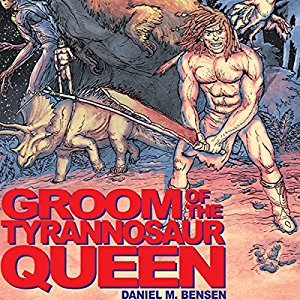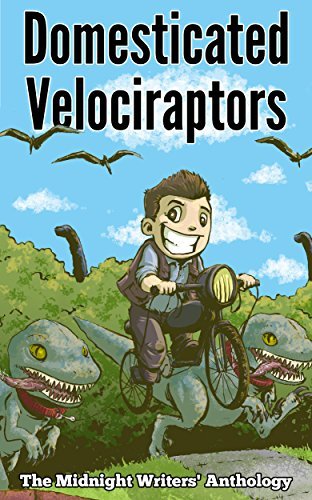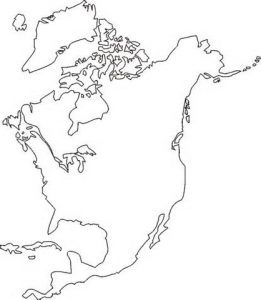Daniel M. Bensen's Blog, page 70
November 10, 2016
We who Peddle: a Mountainbike conlang
The following are excerpts from We who Peddle: the Wewupshkwis language of the Habubshan of Weswufenland.

From the Alps to the Balkans, the fierce Habubshan people (Wepshun habub-shan, literally “we who turn the pedals”) have long held Europe’s high terrains against the inroads of Indo-European peoples. Now, for the first time, we see a reconstruction of the history their language, Chezhuvz wewupsh-kwis (“the mouth-issuing chain of the people”) a non-IE isolate language. Join us, won’t you, on this fascinating journey.
Habuskwupen maunbuk-stavun wekanbus wiilbuz habub, pet maunbuk siigulpost-fenshun stem hapsun hyanus diskwut hab.
—A prayer said by a Habubshan youth upon setting out on his rite of passage.
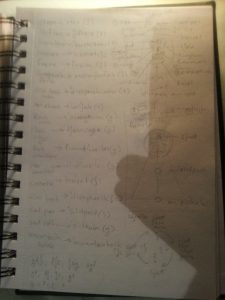
A page from the linguist’s notebook
Sentence structure follows the Wheel-Chain-Pedal system, where the pedal (subject) turns (verb) the chain (object), which turns the wheel (other verbs and objects), but the wheel precedes all as the Mountainbike moves. That is: OVS
Nouns have four genders: stuck, greasy, feel-the-burn, and shiny. Adjectives follow nouns and must agree with nouns. Nominal adjectives have inherent gender. If the inherent gender of the adjective does not agree with the noun, a modifier suffix must be placed on the adjective to cycle it through the genders until it agrees.
ex: fweim (body) is shiny, therefor fweim maunbuk (a Mountainbike’s body, or frame, also shiny) has no need of gender suffixes. However, the king’s body, or the law is not *fweim syatl, because syatl is feel-the-burn, so a modifier must be added: fweim syatl-shan.
Pronouns are based upon the parts of the Wheel: hab (I), spok (you), ta (him/her), and wim (someone far away/outgroup). Plurality is indicated by reduplication (ex: habub=we)
Prepositions are paz (forward), bwek (backward), satl (upward), wil (downward), gwips (adjacent), post (Y-axis), chen (X-axis), and pet (Z-axis).
The parts of the Mountainbike are mapped onto the human body, or fweim.
Person, family, and nation are tied together by the Saddle Hierarchy of “syatl” the brain, householder, or king, “siitpost” the intuition, spouse, or baron, and “siikalaa” the lust, child, or peasant.
Numbers 1-5 are indicated by the Stem Counting System, indicating parts of the body: stem (1, the head), woto (2, from *diskpwekwotoo, the right hand), woto-gwip (3, from *diskpwekwotoo-gwip the left hand), taa (4, from *taiyaa the right foot), and taa-gwip (5, from *taiyaa-gwip, the left foot)
A small Wewupshkwis vocabulary:
(chezhuvz) wewupshkwis (g)- the Wewupsh language (cyclists-greasy language)
(habl) weswufen habub (f)- Weswufenland (we cyclists-stuck-greasy-feel-the-burn home)
(wewupsh) habubshan (sh)- the Habubshan people (We-shiny cyclists)
chezhuvz (g)- a language, from *chein-paz-shifteez (mouth go chain)
diskwut (s)- to get, from *diskpwekwotoo (a hand)
fenshan (sh)- greasy-shiny modifier, from *fiifpen-shain
gwifun (f)- shiny-feel-the-burn modifier, from *gwiis-fifpen
hab (f)- a place, from *hab (center)
hab- I, from *hab (center)
habl (f)- a home, from *hab-petl (heart place)
habub- we, from *hab-hab (center center)
habuskwupen (f)- a shop, from *hab-diskpwekwotoo-gwiis-fiifpeen (get-greasy-feel-the-burn place)
hapsun (sh)- my (shiny), from *hab-shain
hyanus- can, from *hyantlpaas (eye)
kanbus- can’t, from *bweik-hyantlpaaz (eye not)
maunbuk (sh)-a Mountainbike from *mauntanbaik
paz- forward, from *hyantpaaz (handlebars)
pet- so, adjacent to, from *petl (pedal)
post- tall, from *post (the Y-dimension)
siigul (g)- child, from *siikala (seat collar, the lowest point of the Saddle Heirarchy)
stawun (f)-shiny-stuck-greasy-feel-the-burn modifier, from *stak-gwiis-fiifpen
stem- one, from *stem (the head, first in the Stem counting system)
wek- not, from *bweik (a break)
wekanbus- must, from *bweik-bweik-hyantpaaz (not eye not)
wemb (sh)- a person, from *fweim-hab (center body)
wemubuh (sh)- people, from *fweim-hab-hab (center center body)
wepshun (sh)- a cyclist, from *wemb-wiil-petl (pedal turn person)
wewupsh (sh)- cyclists, from *wemubuh-wiil-petl (pedal turn people)
wiil- to turn, from *wiil (a wheel)
wiilbuz- to go, from *wiil-paz (forward turn)

Groom of the Tyrannosaur Queen: the audiobook
I am very pleased to announce that Groom of the Tyrannosaur Queen, my time-travel romance with dinosaurs, is now available on Audible as an audiobook.
Eric Stachura does a great job of giving Trals and Andrea the voices they deserve. Stay tuned for upcoming promotions and giveaways.

November 8, 2016
November 6, 2016
Generating Events in your Outline
I can never say my outlining process is done, even after I got the basic events of the plot, there are still likely to be plot holes I need to plug, changes based on suggestions from alpha-readers, and the ideas I have while I’m actually writing the manuscript. But I did hit a major milestone in that list last week: the first one. I did the first one.
The outline I have for The Centuries Unlimited is more robust than any of the outlines of my previous books, and I worked for a long time on it (two months plus). It might have taken longer, but fortunately I listened to this episode of Writing Excuses at just the right time (I’m pretty sure it’s this one), and they gave me some great ways to generate events in my outline. Here they are.
Ask, what does the character want?
I’ve had bad luck before with not making my character’s goals clear, or switching goals halfway through the book. Don’t do that. Give the character something they want but can’t have right at the beginning and don’t give it to them until the end (if then). For example:
The Hero wants to win the hand of the princess.
Yes But No And
A goal isn’t enough, though. You need the Hero to do insteresting things in pursuit of that goal. For everything the protagonist tries to do in the story, there’s a question of whether they’ll succede. There can’t ever be an unimitaged sucess until the end of the book, so answering the question with “yes, but” or “no, and” gives the hero something to do next. Here’s how it works:
The Hero tries to slay a dragon. Does it work?
Yes, but that dragon’s blood was cursed, and now the Hero is cursed.
The Hero visits a priest to have the curse removed. Does it work?
No, and the priest, horrified, calls upon the townspeople to pursue the Hero into the forest.
The Hero tries to escape the townspeople. Does it work?
Yes, but the cursed Hero kills a townsperson, provoking them to call in the local knight.
And so on.
Generate and solve problems symmetrically
This was the major breakthrough that let me finish my damn outline. It’s easy to generate problems using Yes And No But, but around the middle of the book, the Hero has to start solving them. At this point, start solving problems in reverse order, so that the last problem created at the middle is the first one solved, and the last one solved is the first problem created (the one that’s central to the plot.) Like so:
The Hero figures out a way to talk to the knight without getting close enough to activate the curse. He enlists the knight’s help.
The knight talks to the townspeople, who agree to drop the whole thing in exchange for some dragon gold.
The priest just feels awful about this whole thing, and removes the curse.
The un-cursed Hero goes off and marries the princess.
This outline is a bit trite, but that’s okay. It needs some cleverer solutions for the problems (which can come from world building and research) and it needs some themes to resonate throughout the action. I might also try to fit this story into a formula like The Hero’s Journey or the Hollywood Formula and see if that suggests any new twists.
What do you guys think? Are there other ways I could tune up this outline?

A ship game for Petrolea
(Petrolea is my novella about environmental conservation and robot dragons)
Who comes up with cheesy pick up lines?
Victor. He has a macro for them.
Who rearranges the bookshelf in alphabetical order?
Neither. Victor keeps his trashy magical realism love stories on his personal cloud, and Feroza mulched her childhood library to protest the paper industry.
Who licks the spoon when they’re baking brownies?
Brownies aren’t a thing in India or Peru, but Victor will have his mom make torta de chocolate for Feroza as soon as get back to Earth. He has fantasies about licking that spoon.
Who buys candles for dinners even though there’s no special occasion?
Victor. There’s a macro for that too! But converting mechanoids into balls of flaming oil wastes oxygen and pisses off Feroza, so he stopped.
Who draws little tattoos on the other with a pen?
Feroza. She has tamed a little mechanoid that spits ink as a defense mechanism.
Who comes home with a new souvenir magnet every time they go on vacation?
Feroza. Except the magnets are small mechanoids and she calls them “samples.” (in private, she calls them “bachcha”)
Who convinces the other to fill out those couple surveys in the back of magazines?
Victor. He has a whole archive of Cosmopolitan Perú on his cloud. He says it’s for “research”?
This one dedicated to @atalantapendrag and @gemofsphene. Did I do this right?
And where can I find more of these? I should do them for the WIP so I can get a better handle on the characters’ relationships.
And other writers, let’s see yours!

November 3, 2016
Release the Goats of Eco-War!
The enemy’s first act if war was to release the goats.
Fisher found the animals well west of the Continental Divide, gorging themselves on his Cascadian undergrowth.
He shot them with his .22, sending their Prairie goatherd running.
Fisher tracked the boy across the Divide and the biostate border. When the Prairie patrol hollered at him, he held up his hands and tried to smile. Fisher had called in his mission, but his backup was hours away if it was coming at all.
“I am here to official apologize for shooting Prairie goats in the Cascadian Biostate,” Fisher said, and the Prairie boarder guards all pulled sour faces.
Fisher knew how this would go. The Prairies had already relayed the conversation back to whatever tractor-mounted yurt the Prairie government called home these days. The reply would take some minutes in coming, and in the mean time, the boarder guards and he would trade light insults. “You Cascadian boys didn’t use to shoot our goats.” “Well you Prairie boys didn’t use to graze them on the wrong side of the rain shadow.” “Seems to me the rain shadow of Cascadia should start at the Cascades and these mountains were the Bitterroots last time I checked.” “A rain shadow’s a rain shadow; is the other side of the Continental Divide Cascadia green or Prairie brown?” “Hey! The color on our flag’s called ‘sere,’ asshole, and it’s that green our animals need.” “Let your animals graze there, and it wont be green much longer.” And on and on.
It was a conversation Fisher had at least once a month, the price he paid for his posting on this contested border. He could have had fun on the Californian border, but that was too far from his family, and the Boreal guards were just crazy.
Fisher’s Prairie interlocutor looked up and put his hand to his ear. “Yes? Yessir. I understand.” He smiled and pointed his rifle at Fisher’s heart.
Which sank. “So it looks like you guys are trying to un-contest our border.”
“Your government declared our goats an act of war,” answered Fisher’s captor. “That means you killing them was retaliation and your coming into our biostate was provocation.”
Fisher licked his lips. “You going to shoot me?”
“Course not,” the enemy soldier smiled. “If you’re dead, you can’t herd goats can you? Come on, let’s turn your side of the border just a bit browner.”

November 1, 2016
Outlining
procedural
yes but. no and
generate problems, whose botched solutions cause more problems up until the middle of the book, at which point you start really solving problems in the reverse order they were introduced

October 27, 2016
“Bataar” in Domesticated Velociraptors
Drafield Zho and his trusty snatcher have lead many hunting expeditions into the dinosaur-haunted wilderness outside the walls of Seneria, but none have included an incognito king on its guest list, and never before has he attempted to hunt the mighty bataar.
That’s “Bataar,” a short story set in the same universe as Groom of the Tyrannosaur Queen. It’s available along with many other great stories in the Domesticated Velociraptors anthology. Here’s their blurb:
What would the world be like if you could hire Velociraptor rides for your daughter’s birthday, race them through jungles, or buy them at the local pet store? Fourteen authors from around the world delve into the prospect of domesticated Velociraptors in these stories full of adventure, wonder, and possibilities. Come explore realities where Velociraptors protect the land, take over kingdoms, and get tamed by grandmothers in the second anthology from the Midnight Writers.
This short story is an old one from back in my OPUS: Dinosaur days. It was actually the inspiration behind Groom of the Tyrannosaur Queen. Hope you like it 
Mirror World
From this discussion on Tumblr…
Expansion into the interior of the Americas by European explorers took a great deal of time, first because of the barrier of the Rocky Mountains, and because it soon became obvious that the only maritime passage to China was around Patagonia.
However, the land between the Atlantic and the Rockies was rich with gold and arable land, prompting early and thorough colonization. Spain enjoyed early success, claiming the entire North American coast up to the San Francisco bay. To this day, these areas are almost exclusively Spanish-speaking, with only a few pockets of Basque- and Nahuatl-speakers.
England managed to carve out a colony around Portland, then aggressively pushed inland, pursuing fleeing natives in search of more deposits. Their poor relations with the Salishan and Wakashan peoples, however, slowed settlement around the Cascades. Sandwiched between the wealthy Spanish to the south and the industrious Huguenots to the north, English colonists eventually found their lands split between both. Some villages with English names remain in California, and of course English remains a significant minority language in l’Americ.
Eventually, it was the Dutch who founded the first successful settlement on New Scotland(1), now the global trading center of Nanster. Although now largely assimilated into greater Americain culture, Dutch influence can still be seen in the architecture, culture, and even the language of New Scotland.
French settlers found continental dominance almost by accident. Good relations with the Wakashan allowed French prospectors to quickly gain access to gold and timber, and the emigration of Calvinist sects from France, Scandinavia, and England prompted a rapid rise in population. During the French Wars of Religion, these “Huguenots” overthrew the Catholic colonial government and established l’Amérique de la Liberté.
Americain government was secular and decentralized, a republic on the Grecco-Roman model that soon spread across the Rockies to the Bay of Colbert(2) and the Great Lakes. In the collapse of the Spanish colonies, L’Americ bought or conquered land south to the Gulf of Mexico, eventually leaving only Diné as a buffer with western California. With the purchase of Zolota(3) from the Russians and the annexation of the Tunas(4), L’Americ assumed its modern borders.
From the bustling streets of Nanster to the pious communes of Adenos(5), from the graceful palaces of the Gulf Coast to the sprawling ranches of Prairie, one may hear French, English, Spanish, Lakota, Mohawk, and Chinese as well as a hundred other languages. Truely, modern L’Americ is a land of contrasts.
(1) Vancouver Island
(2) Hudson Bay
(3) Nova Scotia
(4) The Greater Antilles
(5) Roughly upstate New York

October 25, 2016
Five Star Reviews: The Art of Language Invention
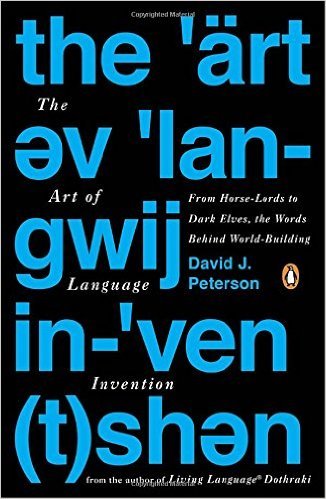
I spent a lot of time waiting in doctors’ offices last week, and I needed something to save me from boredom- and anxiety-induced insanity. What better choice could I have made than The Art of Language Invention by David J. Peterson?
Back when I was a kid, one of my favorite books was Dougal Dixon’s After Man: a Zoology of the Future. As an exercise in speculative biology, the book is responsible for maybe 90% of my enthusiasm about evolution, anatomy, and animal behavior. The fact that I know anything about those subjects at all is because I was enthusiastic for them, which puts Dixon to blame for most of what I know about the natural world. When I read The Art of Language Invention, the same thing happened with linguistics.
You can’t create a good made-up language without knowing about real languages. Through the lens of his invented languages and his experience using them, Peterson educates the reader about the forces that shape the way we speak—a practical gift wrapped in shiny packaging. Like all good speculation, The Art of Language Invention educates and inspires as much as it entertains.
And it IS entertaining, if for no other reason than the cat and onion jokes.
Go read it. I expect to see your new language on my desk by Monday.


